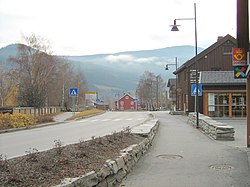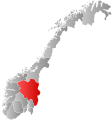Vågå
Vågå kommune | |
|---|---|
 | |
 Coat of arms  Innlandet within Norway | |
 Vågå within Innlandet | |
| Coordinates: 61°50′55″N 9°7′16″E / 61.84861°N 9.12111°ECoordinates: 61°50′55″N 9°7′16″E / 61.84861°N 9.12111°E | |
| Country | Norway |
| County | Innlandet |
| District | Gudbrandsdal |
| Administrative centre | Vågåmo |
| Government | |
| • Mayor (2012) | Iselin Jonassen (Ap) |
| Area | |
| • Total | 1,330 km2 (510 sq mi) |
| • Land | 1,253 km2 (484 sq mi) |
| Area rank | 68 in Norway |
| Population (1.1.2007) | |
| • Total | 3,724 |
| • Rank | 237 in Norway |
| • Density | 3/km2 (8/sq mi) |
| • Change (10 years) | −3.2% |
| Demonym(s) | Vagvær[1] |
| Time zone | UTC+01:00 (CET) |
| • Summer (DST) | UTC+02:00 (CEST) |
| ISO 3166 code | NO-3435 |
| Official language form | Nynorsk[2] |
| Website | www |
Vågå (Norwegian pronunciation: [ˈvôːɡoː]) is a municipality in Innlandet county, Norway. It is part of the traditional region of Gudbrandsdal. The municipality comprises 1,330 km2. The administrative centre is the village of Vågåmo.
The parish of Vaage was established as a municipality on 1 January 1838 (see formannskapsdistrikt). The areas of Sel and Heidal were separated from the municipality of Vågå to become separate municipalities of their own on 1 January 1908.
General information[]
Name[]
Two origins have been suggested for the name Vågå:
- The name Vågå may come from the Old Norse word vega meaning "travel". The area lies on an ancient east–west route mentioned in the Heimskringla.
- The Old Norse form of the name may come from Vaga (accusative and dative cases) from the word Vagi (nominative case). It was probably originally the name of the lake Vågåvatn, but the meaning is unknown. (Maybe derived from vage which means "sleigh runner" since the shape of the lake has some similarity of form with a sleigh runner.)[3]
Prior to 1918, the name was written "Vaage". In 1918, it was changed to "Vaagaa" and in 1921 the spelling was again changed to "Vågå". The letter å is a long vowel similar to "oh" or "aw", like in the American pronunciation of "cold" or "oar."
Coat-of-arms[]
The coat-of-arms is from modern times. They were granted on 23 August 1985. The arms show a gold reindeer on a red background. They are based on a character in Henrik Ibsen's book Peer Gynt, who rides on a reindeer bull over the Besseggen mountains. Ibsen got the idea for this book from a local story.[4]
| Ancestry | Number |
|---|---|
| 34 | |
| 27 | |
| 20 | |
| 14 | |
| 12 |
Geography[]


Vågå is bordered on the north by the municipality of Lesja, in the east by Dovre and Sel, in the southeast by Nord-Fron, in the south by Vang and Øystre Slidre, and in the West by Lom.
The Vågå municipality lies in a mountainous region just to the north of Norway's Jotunheimen National Park, west of Rondane National Park, and south of the Dovrefjell mountains. The highest peak is the Surtningsuen with a height of 2,368 metres (7,769 ft). Vågå includes a mountain road to the top of the1,618-metre (5,308 ft) tall Jetta mountain which provides an unobstructed view of both the Gudbrandsdal Valley and the surrounding national parks.[6]
The river Otta begins in Skjåk municipality and flows into Vågåvatn Lake. Exiting Vågåvatn at Vågåmo, the river continues its journey through the Ottadalen valley leaving Vågå municipality to meet the Gudbrandsdalslågen at Otta in the municipality of Sel. Lakes in the region include Flatningen.
The urban areas in Vågå are the villages of Vågåmo and Lalm.
Climate[]
Vågå lies in the rain shadow from the Jotunheimen mountains which separate Eastern and Western Norway. The climate is hence characterized by a continental climate. Warm summers and cold winters dominate, and the precipitation is very low. In fact some years it is less than 300 millimetres (12 in) of precipitation.[7]
This dry continental climate makes Vågå the obvious place for the national hang glider and para glider centre of Norway.
Physical geography[]
Although being affected by the ice-sheet history spanning the Quaternary period of the last 2.5 million years, much of the landscape are moderately imprinted by ice-sheet erosion except from in the main valleys. Even these valleys including Sjodalen and Ottadalen are of pre-Quaternary origin, and were originally sculptured by fluvial rather than glacial erosion. The numerous lakes does remind us of the glacial history, although being much more limited than in the more dramatic [fiord]s of western Norway.[8]
This limited glacial erosion also means that Vågå had limited glacier erosion during the last glacial period. Many findings of Mammoth pre-dating the last glacial maximum (LGM) have been found, being evidence of the conservative nature of the LGM in the region.
History[]
Vågå is mentioned in the Heimskringla (English: The Chronicle of the Kings of Norway) by Snorri Sturluson. The old Norse saga (Conversion of Dale-Gudbrand) relates that after King Olaf stayed several nights in Lesja, he proceeded south across the uplands to the Ottadal, and the beautiful hamlet lying there on both sides of the Otta river. King Olaf remained there five days, summoning the residents of Vågå, Lom, and Heidal to a meeting (ting). They were advised they must either receive Christianity and give their sons as hostages, or see their habitations burnt. Many submitted to his demands.[9]
Vågå stave church is the second oldest stave church in the country, which was constructed around 1150 and originally dedicated to St. Peter. It was converted to a cruciform church in 1625; the carved portal and wall planks are original. The baptismal font dates from the original church and a Gothic crucifix from the 13th century can be seen there as well.[10]
In 1130, Ivar Gjesling was the earliest-known owner of Sandbu (just north of Vågåmo) in Vågå. He was also King Magnus IV's lendmann for the Opplands. Sigrid Undset's fictional Lady Ragnfrid, wife of Lavrans, was created a Gjesling from Sandbu. Ivar Gjesling, allied himself with the Birchlegs (Birkebeinerne) — who chose Sverre as their king at Øreting in 1177. Sverre granted him the valley of Heidal as a reward.[9]
Farmers from Vågå participated in the successful attack on Scottish mercenary troops journeying to join Swedish forces in 1612. The legends of the Battle of Kringen lives on to this day, including the story of how the peasant girl Prillar-Guri lured the Scots into an ambush by playing of the traditional ram's horn.[9]
Ole Paulssøn Haagenstad (1775–1866) was in 1814 summoned by Christian-Frederick to plan the defense of Gudbrandsdalen in the event of a Swedish attack.[9]

Over 150 houses in the municipality are designated as historic landmarks.
Politics[]
The mayor is elected by the municipal council. Since 1946, all mayors with two exceptions have represented the Norwegian Labour Party. The only non-Labour mayors were Ola O. Kleiven and Kari Hølmo Holen (Norwegian Centre Party).
Øygard case[]
The last election took place in September 2011, when Rune Øygard was reelected as mayor, after having served since 1995. His reelection by the municipal council was controversial as he was already under police investigation for alleged child sexual abuse,[11] the so-called Øygard case, sometimes also referred to as the Vågå case. Øygard was granted temporary leave following his indictment in the case, and was succeeded as acting mayor by Iselin Jonassen (Labour) on 8 May 2012. After being found guilty and sentenced to four years imprisonment, Rune Øygard resigned as mayor. His resignation was granted by the municipal council on 18 December 2012, effective immediately.[12][13]
Notable residents[]


- Edvard Storm (1749 in Vågå - 1794) a Norwegian poet, songwriter and educator
- Johan Storm Munch (1778 at Vågå – 1832) a Bishop in the Church of Norway; poet, playwright and magazine editor
- Jo Gjende (1794 in Vågå – 1884) an outdoorsman and freethinker, may have been the model for Henrik Ibsen’s Peer Gynt
- Ole Herman Johannes Krag (1837 in Vågå – 1916) a Norwegian officer and firearms designer
- Ivar Kleiven (1854 in Vågå - 1934) politician, historian, poet and collector of local folklore
- Kristian Prestgard (1866 in Heidal -1946) an American journalist and author, editor of Decorah-Posten
- Kristen Holbø (1869 in Vågå – 1953) a painter of landscapes and illustrator
- Thekla Resvoll (1871 in Vågå – 1948) a Norwegian botanist and educator
- Benjamin Blessum (1877-1954) Norwegian-American painter and illustrator, parents from Vågå
- Ragnvald Skrede (1904 in Vågå - 1983) an author, journalist, literature critic and poet
- Ivar P. Enge (1922 in Vågå – 2013) a Norwegian radiologist, specializing in interventional radiology
- Arne Brimi (born 1957) a Norwegian chef and food writer; lives and works in Vågå
Sister cities[]
The following cities are twinned with Vågå:[14]
References[]
- ^ "Navn på steder og personer: Innbyggjarnamn" (in Norwegian). Språkrådet.
- ^ "Forskrift om målvedtak i kommunar og fylkeskommunar" (in Norwegian). Lovdata.no.
- ^ Rygh, Oluf (1900). Norske gaardnavne: Kristians amt (in Norwegian) (4 ed.). Kristiania, Norge: W. C. Fabritius & sønners bogtrikkeri. pp. 68–69.
- ^ Norske Kommunevåpen (1990). "Nye kommunevåbener i Norden". Archived from the original on 2007-07-15. Retrieved 2009-01-03.
- ^ "Immigrants and Norwegian-born to immigrant parents, by immigration category, country background and percentages of the population". ssb.no. Archived from the original on 2 July 2015. Retrieved 29 June 2015.
- ^ Welle-Strand, Erling (1996). Adventure Roads in Norway. Nortrabooks. ISBN 978-82-90103-71-7.
- ^ Lemmer, Gerhard; Frey, Elke; Rahe, Helge (2001). Norway (2 ed.). Nelles Verlag GmbH. ISBN 3-88618-897-3.
- ^ Cornwallis, Graeme; Bender, Andrew; Swaney, Deana (2002). Loney Planet Norway (2 ed.). Lonely Planet Publications. ISBN 978-1-74059-200-0.
- ^ Jump up to: a b c d Stagg, Frank Noel (1956). East Norway and its Frontier. George Allen and Unvin, Ltd.
- ^ Taylor-Wilkie, Doreen, ed. (1996). Insight Guides Norway (2 ed.). Houghton Mifflin Company. ISBN 978-0-395-81912-8.CS1 maint: multiple names: authors list (link) CS1 maint: extra text: authors list (link)
- ^ "Overgrepssiktede Rune Øygard (Ap) gjenvalgt som ordfører".
- ^ "Rune Øygard trekker seg som ordfører".
- ^ http://vaga.kommune.no/Modules/article.aspx?ObjectType=Article&Article.ID=3577&Category.ID=546[permanent dead link]
- ^ "Vennskapskommuner" (in Norwegian). Vågå kommune. Archived from the original on 2011-07-24. Retrieved 2009-01-03.
External links[]
| Wikimedia Commons has media related to Vågå. |
| Look up Vågå in Wiktionary, the free dictionary. |
- Municipal fact sheet from Statistics Norway
 Oppland travel guide from Wikivoyage
Oppland travel guide from Wikivoyage- Map of Vågå municipality in Kulturnett.no (in Norwegian)
- Vågå Wavecamp
- Vågå
- Municipalities of Oppland


